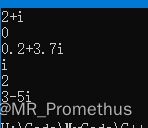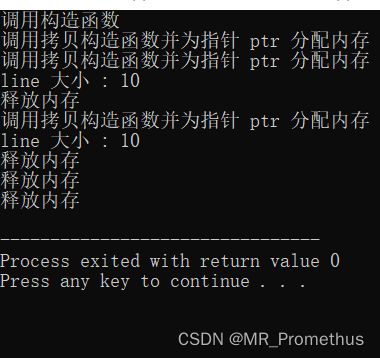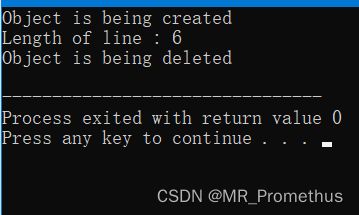【C++面向对象】2.构造函数、析构函数
文章目录
- 【 1. 构造函数 】
-
- 1.1 带参构造函数--传入数据
- 1.2 无参构造函数--不传入数据
- 1.3 实例
- 1.4 拷贝构造函数
- 【 2. 析构函数 】
【 1. 构造函数 】
- 类的构造函数是类的一种特殊的成员函数,它会 在每次创建类的新对象时执行。
- 构造函数的名称与类的名称是完全相同的,并且 不会返回任何类型,也不会返回 void。构造函数可 用于为某些成员变量设置初始值。
1.1 带参构造函数–传入数据
- 法1
class Complex
{
private:
double x;
double y;
public:
Complex(); //无参构造函数
Complex(double, double); //带参构造函数
void Complex_Printf(void); //输出函数
};
//带参构造函数--形式1
Complex::Complex(double a, double b)
{
x = a;
y = b;
}
- 法2
class Complex
{
private:
double x;
double y;
public:
Complex(); //无参构造函数
Complex(double, double); //带参构造函数
void Complex_Printf(void); //输出函数
};
//带参构造函数--形式2
Complex::Complex(double a,double b) :x(a), y(b) { };
1.2 无参构造函数–不传入数据
- 法1
class Complex
{
private:
double x;
double y;
public:
Complex(); //无参构造函数
Complex(double, double); //带参构造函数
void Complex_Printf(void); //输出函数
};
//无参构造函数:默认值x=2,y=1
Complex::Complex()
{
x=2;
y=1;
};
- 法2
class Complex
{
private:
double x;
double y;
public:
Complex(); //无参构造函数
Complex(double, double); //带参构造函数
void Complex_Printf(void); //输出函数
};
//无参构造函数:默认值x=2,y=1
Complex::Complex() :x(2), y(1) { };
1.3 实例
// 【Complex.h】
#pragma once
class Complex
{
private:
double x;
double y;
public:
Complex(); //无参构造函数
Complex(double, double); //带参构造函数
void Complex_Printf(void); //输出函数
};
// 【 Complex.cpp 】
#include "Complex.h"
#include // 【 Main.cpp 】
#include 1.4 拷贝构造函数
- 拷贝构造函数是一种特殊的构造函数,它在创建对象时,是 使用同一类中之前创建的对象来初始化新创建的对象。
- 如果在类中没有定义拷贝构造函数,编译器会自行定义一个。如果类带有指针变量,并有动态内存分配,则它必须有一个拷贝构造函数。
- 拷贝构造函数通常用于:
- 通过 使用另一个同类型的对象来初始化新创建的对象。
- 复制对象把它作为参数传递给函数。
- 复制对象,并从函数返回这个对象。
- 拷贝构造函数的常见形式:
classname (const classname &obj)
{
// 构造函数的主体
}
- 实例1:
- Line line(10); // 创建一个Line类的对象line,会调用构造函数,输出 “调用构造函数”
- display(line); // 使用 line 作为参数传入display函数中时,系统首先会调用拷贝构造函数为 line 进行复制创建得到一个临时副本,输出 “调用拷贝构造函数并为指针 ptr 分配内存”
系统使用该副本在 display 函数中 进行操作,输出 “line 大小 :10”,display 函数结束后该副本作为局部变量被回收,输出 “释放内存”- 对象 Line 在主程序结束前 也将被回收,输出 “释放内存”
#include - 实例2:
- Line line1(10); // 创建一个Line类的对象line1,会调用构造函数,输出 “调用构造函数”
- Line line2 = line1; // 创建一个Line类的对象line2 且 lin2 是由 lin1 复制得到,即调用了拷贝构造函数,输出 “调用拷贝构造函数并为指针 ptr 分配内存”
- display(line1); // 使用 line1 作为参数传入display函数中时,系统首先会调用拷贝构造函数为 line1 进行复制创建得到一个临时副本,输出 “调用拷贝构造函数并为指针 ptr 分配内存”
系统使用该副本在 display 函数中 进行操作,输出 “line 大小 :10”
display 函数结束后该副本作为局部变量被回收,输出 “释放内存”- 同样地, display(line2); // 使用 line2 作为参数传入display函数中时,系统首先会调用拷贝构造函数为 line2 进行复制创建得到一个临时副本,输出 “调用拷贝构造函数并为指针 ptr 分配内存”
系统使用该副本在 display 函数中 进行操作,输出 “line 大小 :10”
display 函数结束后该副本作为局部变量被回收,输出 “释放内存”- 对象 Line1 和Line2 在主程序结束前 也将被回收,分别输出 “释放内存”
#include 【 2. 析构函数 】
-
类的析构函数是类的一种特殊的成员函数, 类的析构函数会在每次删除所创建的对象时执行。
-
析构函数的 名称与类的名称是完全相同的,只是在前面加了个 波浪号(~) 作为前缀,它 不会返回任何值,也 不能带有任何参数。
-
析构函数 有助于在跳出程序(比如关闭文件、释放内存等)前释放资源。
-
如果程序里没有构造函数和析构函数,编译器在编译的时候会自动生成构造函数和析构函数,只是函数内没有任何操作。
-
实例
#include 


